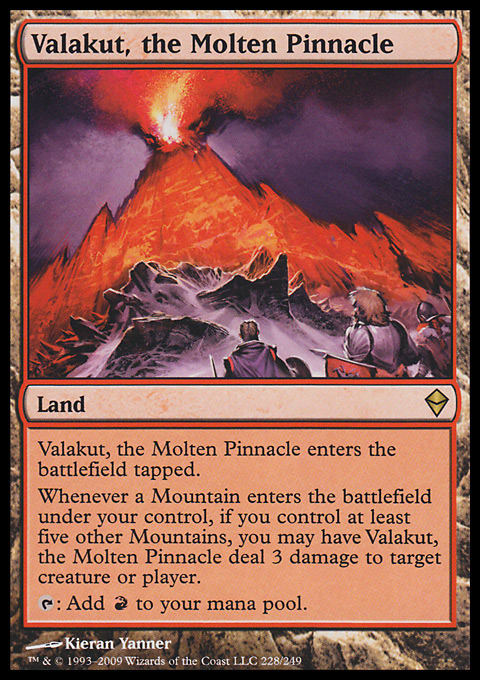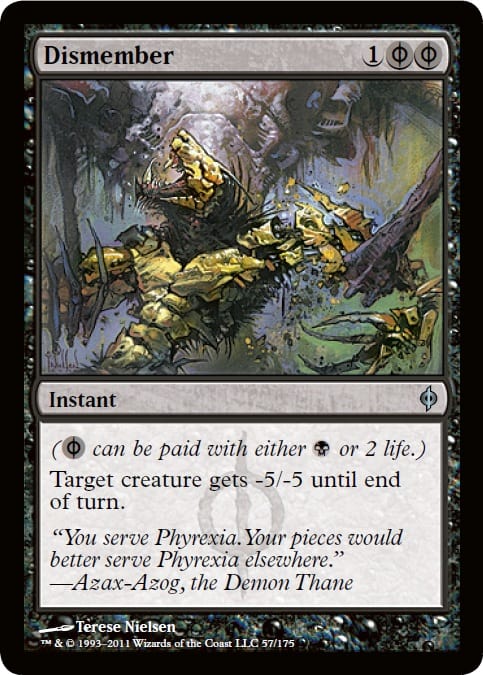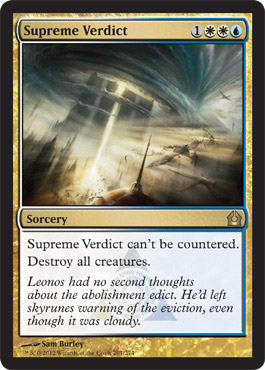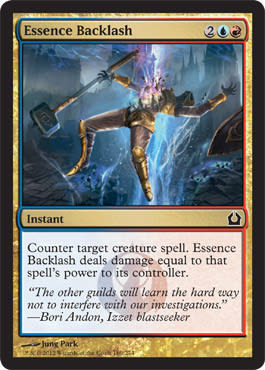In the highest levels of completive play, punting takes on an even more demanding standard. It’s not merely about avoiding obvious errors; it’s about making the correct judgment calls with less obvious information to go on. This kind of subtle decision-making is what separates the champs from the chumps at the pro level. As the head judge at Pro Tour: Return to Ravnica seemed to suggest in his opening remarks, on some level, just making it to the Pro Tour makes players be considered champs. He reminded us that we’re a few hundred players representing millions of Magic players. While this may be true, there still needs to be something that separates the best of the best from the rest.
Given the accomplishments that landed me in the MTG Pro Tour Hall of Fame, I have frequently made the types of decisions needed to rise to the top of the heap and be a champ. PT:RTR was not one of those times. This time, I was one of the chumps.
Things started out well enough. I chose a strong Modern deck and built a good version. I knew I didn’t have much time to design and playtest a deck from scratch for the event, so I ended up choosing a deck that I have considerable experience with that I think is quite powerful:
"Affinity"
- Creatures (24)
- 4 Arcbound Ravager
- 4 Frogmite
- 4 Master of Etherium
- 4 Memnite
- 4 Ornithopter
- 4 Vault Skirge
- Spells (20)
- 4 Galvanic Blast
- 4 Thoughtcast
- 4 Cranial Plating
- 4 Springleaf Drum
- 4 Mox Opal
- Lands (16)
- 4 Blinkmoth Nexus
- 4 Glimmervoid
- 4 Inkmoth Nexus
- 4 Darksteel Citadel
- Sideboard (15)
- 3 Ethersworn Canonist
- 3 Blood Moon
- 3 Whipflare
- 2 Ancient Grudge
- 4 Etched Champion
I was very happy with this build. I played it in a Modern event at Grand Prix: San Jose the weekend before for a piece of original art (Wall of Bone), and I went 5–0. At that event, I played against one Valakut, the Molten Pinnacle deck, one W/B tokens deck, and three Tarmogoyf decks of various three-color combinations. Since at least four of my opponents were pro players practicing for the Pro Tour, I left feeling pretty good about my Modern deck going into the Pro Tour. At the actual Pro Tour, I played against two Valakut decks, two affinity decks, and one Jund deck. These matchups did little to make me question my deck choice. I’d beaten both Jund and Valakut the week before, and the presence of mirror matches suggested I wasn’t the only one to think affinity was a good choice. Much to my surprise and disappointment, I went 2–3 in Modern. I beat Jund, which I expected after going 3–0 against similar decks the week before. I went 1–1 in the Mirror, which isn’t too bad, but I went 0–2 against Valakut.
The excruciating thing is that in two of the three matches, there was a judgment call I made that was almost certainly the difference between victory and defeat. If I had made the right call at those two points, those would have been wins instead of losses. These weren’t mistakes—like tapping my mana wrong, putting Cranial Plating on the wrong creature, miscalculating the damage my opponent could do when he attacks, making the wrong blocks, or something like that. These were tough judgment calls that seemed like the right play at the time, but calls that didn’t work out; and I think perhaps given more thought, I would have made the other choice and been victorious.
The first judgment call I regret comes from one of my Valakut matchups. When I beat Valakut the week before, I only had one Blood Moon in my sideboard, but afterward, he admitted it was a real problem for his deck, and it proved to be useful in some other matchups. I added two more to my board for the PT. So when I ran into Valakut at the Pro Tour, I boarded all three in. In Game 2 of Round 1, I had one in my opening hand. The judgment call came when I hit 3 mana and had to decide whether to play it. My opponent was tapped out, so it was good time to play it from that perspective since I knew he had at least some permission in his deck. However, I didn’t have much pressure on him, and if I spent the turn playing threats, I would put him on a good clock. In Modern, every turn taken going for the kill with an aggressive deck is crucial. I decided to start the clock and then play the Blood Moon the next turn. After all, I could tell he wasn’t ready to go off yet, and so why not bring his life lower in the meantime? I still think this was a reasonable line of play on my part, and I think many players might have made the same call and not given it any later thought. Of course had it worked, I’m sure I wouldn’t be second-guessing my decision.
Well, it didn’t work. On the next turn, he countered the Blood Moon and drew and played enough removal on my threats to buy the needed time to go off and kill me. In retrospect, I think I should have played the Blood Moon immediately. Sure, he has basic lands in his deck and probably even has a couple cards that can take the Moon off the table. It would certainly slow him down, however. While it would slow down my development for a turn, I think that most of the time, it will slow him down for much more than that. Of course, had he not had permission available on the turn I actually cast the Moon, it would be irrelevant, but why take the risk? I have way more threats than Blood Moons in my deck—much better to have a threat countered. Obviously, this isn’t black and white. Perhaps if I’d played it the other way, I would have lost anyway. That’s why this is about a judgment call and not a “mistake.” In hindsight, I feel that the other play would have increased my chances of winning; thus, I’m frustrated with the choice I actually made.
The second judgment call came in Round 5 and was much more excruciating. For the first time in a Pro Tour, I was matched up against Paul “Little Darwin” Rietzl. I didn’t realize it prior to our match, but it turns out he was also playing an affinity deck. This actually hurt me in our match because I kept making the mistake of forgetting that he might play with cards that I wasn’t using in my deck or sideboard. Game 1, he pretty much emptied his hand on turn one. While he was able to put me on a clock, it wasn’t a very short one since he didn’t have any of his big-threat cards. While I pretty much said, “Land, go,” on my first turn, I quickly ended up playing multiple big-threat cards, and my two Master of Etherium soon gave me a decisive advantage.
Game 2 was a much wilder affair. He brought out two Steel Overseers, and I brought out two Cranial Platings, so the race was on. Unfortunately, with neither of us having colored mana, the race didn’t appear to favor me. My Platings didn’t increase toughness, so whichever threats I equipped, he could trade with. In the meantime, his entire team was growing larger. Unless he ran out of threats first (which didn’t seem to be happening), I was in trouble in the long game. Fortunately for me, I drew colored mana first. This would enable me to make use of the Ancient Grudge in my hand. So . . . how best to use it? I figured it would end up being in one of two ways: Either kill both Overseers and hope for the best against the rest of his now-relatively-beefy-sized team or go after his potential blockers with flying as I tried to kill him in the air. This was complicated by the fact that I only had one source of colored mana, so I couldn’t just destroy two things on the same turn.
As a result, I waited to see what Paul did on his turn to help me decide on my best course of action. This seemed to work out great. On his turn, Paul drew his first colored-mana source in the form of a Springleaf Drum. When he said “go,” his only available mana was the Drum and a Blinkmoth Nexus. This meant I could kill two birds with one stone. By blowing up the Drum with my Grudge, I would both completely deprive him of colored mana and of having a flying blocker on my turn. On my turn, I proceeded to use my mana to activate an Inkmoth Nexus, equip it with two Platings, and attack for what I believed would be lethal poison damage. Given that he had no flying blockers and only a single colorless mana, I was certain the match was now over in my favor . . . or not . . . Dismember! Without access to mana for my Grudge, with one fewer blocker, and having failed to kill any of his creatures the first time I used the Grudge, he was now able to alpha strike for the win.
You might say it was a pretty understandable judgment call, even if I had considered the existence of Dismember before attacking, except for one thing: the Dismember already in his graveyard that he’d played earlier in the game . . . I had the information to know that not only was the card a possibility, but that it was a card he was playing with! Now, it was still a judgment call, not a straight mistake, for a couple reasons: First, I might have lost anyway had I been more cautious, and the fact that he’d played a Dismember previously didn’t mean he had one in his hand now. With an Ancient Grudge available to me, I suspect there would have been a line of play available to me with a better chance for success (especially since this one is now a confirmed failure!), but with his strong board backed up by a Dismember, I’m not sure.
So, I stumbled into Draft with a record of 2–3, but still only needing to go 2–1 in Draft to make Day 2. I drafted a pretty solid Selesnya deck:
"Selesnya Draft Deck"
- Creatures (15)
- 1 Armory Guard
- 1 Bazaar Krovod
- 1 Centaur Healer
- 1 Gobbling Ooze
- 1 Golgari Longlegs
- 1 Vitu-Ghazi Guildmage
- 2 Korozda Monitor
- 2 Stonefare Crocodile
- 2 Towering Indrik
- 3 Drudge Beetle
- Spells (8)
- 1 Selesnya Charm
- 1 Swift Justice
- 2 Giant Growth
- 3 Common Bond
- 1 Collective Blessing
I went into the Draft hoping to draft Selesnya. Unfortunately, it dried up pretty quick in pack one, but black came so late that I started to think I would end up in Golgari. This seemed to be confirmed when I received a fourth-pick Necropolis Regent in pack two, but I then found a fifth-pick Collective Blessing! Does this mean all three players to my left were either Izzet or Azorius? Fortunately, pack three turned out to have good G/W, and I was happy with the deck I ended up with. The biggest disappointment was that I ended up with only three 3-drops. Every other time I’ve played Selesnya, I’ve had a major glut at 3 mana, so I didn’t prioritize it; plus, since I thought I was going to go Golgari, I ended up with three black 3-drops, which would have given me a total of five had I stayed with Golgari, which would have been just right. If one of my 5-drops had been a 3-drop, I would have been completely satisfied with my deck. As it turns out, I found myself constantly sideboarding out the Bazaar Krovod for a Chorus of Might. I thought seven pump spells would be plenty and that with that much pump and a Blessing, I needed to play as many creatures as possible, but it turns out it’s really hard to have too much pump in G/W.
In the first round of Draft, I defeated Luis Scott-Vargas and his Golgari deck, so I thought I was in great shape, just needing to win one of my two remaining rounds. Boy was I wrong . . . In the penultimate round, I faced an Azorius deck. After he won Game 2 with the help of Supreme Verdict, I became more skittish about committing all of my threats onto the board. This backfired on me in Game 3. I developed a big board full of creatures, and in part because I had Vitu-Ghazi Guildmage and was almost at 6 mana, I held a few creatures back. Soon, I was making two Centaur tokens a turn, and I thought I was favored to win. Unfortunately, he had just enough game to pull out a win without drawing Supreme Verdict. He stifled one of my big ground attacks with a Rootborn Defenses and was eventually able to deal with my Towering Indrik long enough to force through just enough damage in the air to kill me a turn before I could kill him. I pretty sure that had I ignored the possibility of Supreme Verdict and played out my creatures as fast as possible, that would have been just enough to earn me the win.
Once again, this wasn’t a straight mistake. Had I just emptied my hand of creatures when I already had board advantage, with my opponent having multiple cards in hand and he’d then played Supreme Verdict, I would have felt much worse. Yet, in that sort of situation, it’s crucial to correctly judge just how much you need to play in order to gain a sufficiently big enough advantage that the only way for your opponent not to lose is to play his mass-removal spell. Obviously, I failed to make that judgment correctly.
In Round 8, I had one final chance to earn my fourth win and thus advance to Day 2. In Game 2, I had two creatures countered with Essence Backlash, and this was a big part of the reason I lost a very close game. Unfortunately, it also led me into making a bad judgment call in Game 3. When I made it to 5 mana, neither of us had much in play, and I had been planning on playing a Golgari Longlegs. Unfortunately, he had 4 mana open and could easily be waiting to play an Essence Backlash. Not wanting to lose my Longlegs and take 5 damage, I decided to wait until either he didn’t have four lands untapped or until I drew another land and could play two smaller creatures in the same turn. This worked out great . . . for my opponent. After I announced that I was ending my turn, he proceeded to play an Inspiration. When I later played my Longlegs at a time when he only had 3 mana available, he Canceled it. Turns out he didn’t even draw a Backlash that game. Thanks to me time-walking myself, though, he was able to spend a turn drawing cards without falling behind on the board and helping him make it to his superior late game, which included multiple Dragons.
Had I made the correct read on him—holding Inspiration and not holding Backlash—I think my play would have been correct. Given that I had enough information to know that I needed to be the aggressor in our matchup, I think I should have just run a 3-drop out there and hoped for the best. Again, I had made a crucial judgment call that backfired and that directly led to my defeat.
Results-wise, a bad judgment call is just as bad as a blatant mistake. Making a bad call generally doesn’t hurt as bad afterward as a clear mistake, but at least in this case, it’s hard for me to be sure or to care. Every time I have the opportunity to do well in a big event and it slips through my fingers, it’s painful, but this one seems to hurt more than usual. Learning to deal with this sort of pain and grow from it is a big part of being a successful Magic player, of course, but I’d prefer to focus on doing well enough to avoid this pain. Given my past success, I certainly wouldn’t ask you to feel sorry for me, but be sure that no matter how successful you are, losing never stops hurting, especially when there are clear points when crucial decisions of yours directly led to your defeat. While we can certainly debate what should or shouldn’t be defined as punting in Magic, after PT:RTR, I sure felt like a world-class punter . . .
Good Magic players learn how to avoid blatant mistakes. Great Magic players learn to make the right judgment calls, too. In the end, while they’re clearly two different things, you still need to master both of them, and they can be equally crucial to your chances of winning. The skill sets involved with making the right calls in Magic are huge parts of achieving big-time success in Magic: weighing your options, evaluating risk, considering the available evidence, making good reads, and playing the odds. While no one makes the right judgment calls every time, you can be sure champions are making most of them right—most of the time.





























